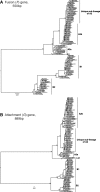The role of human Metapneumovirus genetic diversity and nasopharyngeal viral load on symptom severity in adults
- PMID: 29792212
- PMCID: PMC5966857
- DOI: 10.1186/s12985-018-1005-8
The role of human Metapneumovirus genetic diversity and nasopharyngeal viral load on symptom severity in adults
Abstract
Background: Human metapneumovirus (HMPV) is established as one of the causative agents of respiratory tract infections. To date, there are limited reports that describe the effect of HMPV genotypes and/or viral load on disease pathogenesis in adults. This study aims to determine the role of HMPV genetic diversity and nasopharyngeal viral load on symptom severity in outpatient adults with acute respiratory tract infections.
Methods: Severity of common cold symptoms of patients from a teaching hospital was assessed by a four-category scale and summed to obtain the total symptom severity score (TSSS). Association between the fusion and glycoprotein genes diversity, viral load (quantified using an improved RT-qPCR assay), and symptom severity were analyzed using bivariate and linear regression analyses.
Results: Among 81/3706 HMPV-positive patients, there were no significant differences in terms of demographics, number of days elapsed between symptom onset and clinic visit, respiratory symptoms manifestation and severity between different HMPV genotypes/sub-lineages. Surprisingly, elderly patients (≥65 years old) had lower severity of symptoms (indicated by TSSS) than young and middle age adults (p = 0.008). Nasopharyngeal viral load did not correlate with nor predict symptom severity of HMPV infection. Interestingly, at 3-5 days after symptom onset, genotype A-infected patients had higher viral load compared to genotype B (4.4 vs. 3.3 log10 RNA copies/μl) (p = 0.003).
Conclusions: Overall, HMPV genetic diversity and viral load did not impact symptom severity in adults with acute respiratory tract infections. Differences in viral load dynamics over time between genotypes may have important implications on viral transmission.
Keywords: Acute respiratory tract infection; Genetic diversity; Human metapneumovirus (HMPV); Symptom severity; Viral load.
Conflict of interest statement
Ethics approval and consent to participate
The study was approved by the University of Malaya Medical Centre (UMMC) Medical Ethics Committee (MEC890.1). Standard, multilingual consent forms permitted by the Medical Ethics Committee were used and written consent was obtained from all study participants. All experiments were performed in accordance with approved guidelines and regulations.
Consent for publication
We have obtained the written consent from participants to publish the data.
Competing interests
The authors declare that they have no competing interests.
Publisher’s Note
Springer Nature remains neutral with regard to jurisdictional claims in published maps and institutional affiliations.
Figures


Similar articles
-
Epidemiology and genotypic diversity of human metapneumovirus in paediatric patients with acute respiratory infection in Beijing, China.Virol J. 2021 Feb 18;18(1):40. doi: 10.1186/s12985-021-01508-0. Virol J. 2021. PMID: 33602245 Free PMC article.
-
Genetic diversity and molecular evolution of the major human metapneumovirus surface glycoproteins over a decade.J Clin Virol. 2013 Nov;58(3):541-7. doi: 10.1016/j.jcv.2013.08.029. Epub 2013 Sep 4. J Clin Virol. 2013. PMID: 24041471
-
Molecular epidemiology of human metapneumovirus in Ireland.J Med Virol. 2008 Mar;80(3):510-6. doi: 10.1002/jmv.21081. J Med Virol. 2008. PMID: 18205227
-
[Human metapneumovirus as a common cause of respiratory tract disease].Vopr Virusol. 2007 May-Jun;52(3):4-8. Vopr Virusol. 2007. PMID: 17601042 Review. Russian.
-
Epidemiology of human metapneumovirus.Clin Microbiol Rev. 2006 Jul;19(3):546-57. doi: 10.1128/CMR.00014-06. Clin Microbiol Rev. 2006. PMID: 16847085 Free PMC article. Review.
Cited by
-
Human metapneumovirus as cause of severe community-acquired pneumonia in adults: insights from a ten-year molecular and epidemiological analysis.Ann Intensive Care. 2019 Jul 24;9(1):86. doi: 10.1186/s13613-019-0559-y. Ann Intensive Care. 2019. PMID: 31342206 Free PMC article.
-
Clinical human metapneumovirus isolates show distinct pathogenesis and inflammatory profiles but similar CD8+ T cell impairment.mSphere. 2024 Jan 30;9(1):e0057023. doi: 10.1128/msphere.00570-23. Epub 2024 Jan 10. mSphere. 2024. PMID: 38197640 Free PMC article.
-
Global Extension and Predominance of Human Metapneumovirus A2 Genotype with Partial G Gene Duplication.Viruses. 2022 May 16;14(5):1058. doi: 10.3390/v14051058. Viruses. 2022. PMID: 35632799 Free PMC article.
-
Identification of viral etiology of acute respiratory tract infections in children and adults in Tabanan, Bali, Indonesia.Access Microbiol. 2020 Mar 25;2(6):acmi000120. doi: 10.1099/acmi.0.000120. eCollection 2020. Access Microbiol. 2020. PMID: 32974585 Free PMC article.
-
Detection of multiple viral sequences in the respiratory tract samples of suspected Middle East respiratory syndrome coronavirus patients in Jakarta, Indonesia 2015-2016.Int J Infect Dis. 2019 Sep;86:102-107. doi: 10.1016/j.ijid.2019.06.022. Epub 2019 Jun 22. Int J Infect Dis. 2019. PMID: 31238156 Free PMC article.
References
Publication types
MeSH terms
Grants and funding
LinkOut - more resources
Full Text Sources
Other Literature Sources

